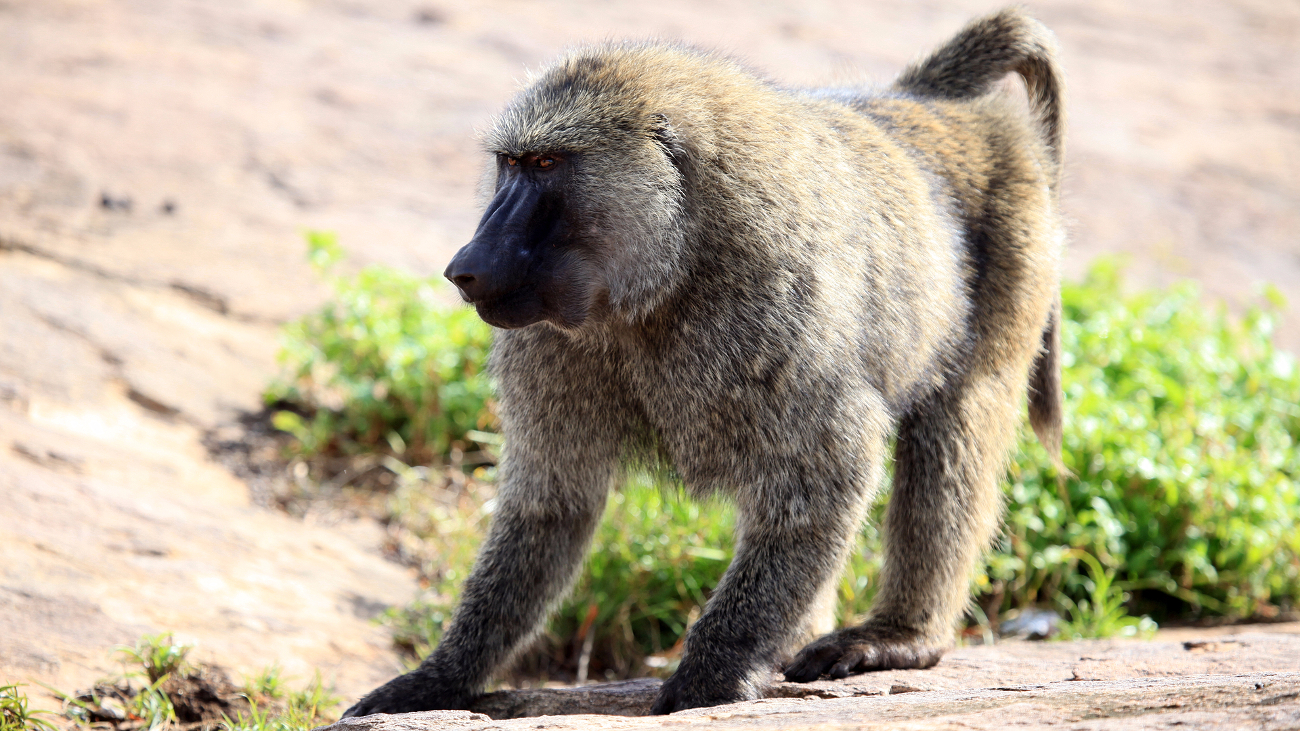- Home
- Conservancy
- Olive baboon
Description
The olive baboon is named for its coat, which, at a distance, is a shade of green-grey. Its alternative name comes from the Egyptian god Anubis, who was often represented by a dog head resembling the dog-like muzzle of the baboon. At closer range, its coat is multicolored, due to rings of yellow-brown and black on the hairs. The hair on the baboon's face, however, is coarser and ranges from dark grey to black.
This coloration is shared by both sexes, although males have a mane of longer hair that tapers down to ordinary length along the back. Besides the mane, the male olive baboon differs from the female in terms of size and weight, and canine tooth size; males are, on average, 70 cm (28 in) tall while standing and females measure 60 cm (24 in) in height. The olive baboon is one of the largest species of monkey; only the chacma baboon and the mandrill attain similar sizes.
The head-and-body length can range from 50 to 114 cm (20 to 45 in), with a species average of around 85 cm (33 in). At the shoulder on all fours, females average 55 cm (22 in) against males, which average 70 cm (28 in). The typical weight range for both sexes is reportedly 10
Fun Facts
The olive baboon lives in groups of 15 to 150, made up of a few males, many females, and their young. Each baboon has a social ranking somewhere in the group, depending on its dominance. Female dominance is hereditary, with daughters having nearly the same rank as their mothers, and adult females forming the core of the social system. Female relatives form their own subgroups in the troop. Related females are largely friendly to each other.
They tend to stay close together and groom one another, and team up in aggressive encounters within the troop. Female kin form these strong bonds because they do not emigrate from their natal groups. Occasionally, groups may split up when they become so large that competition for resources is problematic, but even then, members of matrilines tend to stick together. Dominant females procure more food, matings, and supporters.
Among olive baboons in Tanzania, high-ranking females give birth at shorter intervals to infants with a higher survival rate, and their daughters tend to mature faster than low-ranking females. However, these high-ranking females also appear to have a higher probability of miscarriages and some high-ranking matrilines have inexplicably low fertility. One theory suggests this occurs due to stress on the high-ranking females, although this theory is controversial. A female often forms a long-lasting social relationship with a male in her troop, known as a "friendship".
These nonsexual affiliative friendships benefit both the male and female. Males benefit from these relationships because they are usually formed soon after he immigrates into a new group, and helps the male integrate into the group more easily. He could also potentially end up mating with his female friend in the future. Females gain protection from threats to themselves and their infants (if they have any). Males occasionally "baby-sit" for their female friends, so she can feed and forage freely without the burden of having to carry or watch the infant.
Sexually receptive females and newly immigrated males can form such friendships. These relationships are sometimes enduring and the pair grooms and remains close to each other. They also travel, forage, sleep, and raise infants together, as well as fight together against aggressive conspecifics. Males establish their dominance more forcefully than females. A male disperses, or leaves his natal group and joins another group, after reaching sexual maturity. Adult males are very competitive with each other and fight for access to females.
Higher dominance means better access to mating and earlier access to food, so naturally a great deal of fighting over rank occurs, with younger males constantly trying to rise in position. Because females stay with their groups their entire lives, and males emigrate to others, often a new male challenges an older one for dominance. Frequently, when older baboons drop in the social hierarchy, they move to another tribe. The younger males who pushed them down often bullies and harasses them. Older males tend to have more supportive and equal relationships than those of the younger males.
The former may form coalitions against the latter. Despite being hierarchical, baboons appear to be "democratic" when it comes to deciding the direction of collective movement. Individuals are more likely to follow when multiple decision-makers agree on what direction to go rather than simply following dominant individuals.
